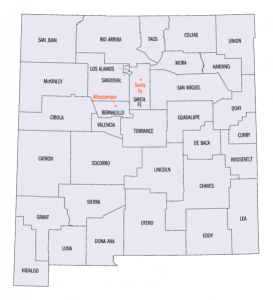NewsDesk @bactiman63
New Mexico state health officials report six hantavirus pulmonary syndrome (HPS) cases, including two deaths since the beginning of 2023.
 The individuals resided in McKinley, San Juan, and Taos Counties. The four surviving patients were all hospitalized and required oxygen or intensive care before being discharged to go home.
The individuals resided in McKinley, San Juan, and Taos Counties. The four surviving patients were all hospitalized and required oxygen or intensive care before being discharged to go home.
On average, three or four people are typically diagnosed with HPS over the course of a year in New Mexico.
As of the end of 2021, 850 cases of hantavirus disease were reported in the United States since surveillance began in 1993. These were all laboratory-confirmed cases and included HPS and non-pulmonary hantavirus infection.
New Mexico reported 119 cases during this period, including 51 deaths (43% CFR).
“Everyone in New Mexico should learn about hantavirus infections and take the necessary steps to minimize possible exposures,” said Dr. Chad Smelser, NMDOH Deputy State Epidemiologist. “The key to preventing infections is to avoid exposure to rodents and their nests.”
HPS is a severe respiratory illness caused by the Sin Nombre virus. In New Mexico, deer mice are the main carriers of hantavirus. The virus is found in mice droppings and urine.

Image/CDC
A person may get HPS by breathing in the virus. This can happen when droppings or urine containing the virus are stirred up and the virus is put into the air as mist or dust. Persons can also get hantavirus by touching their eyes, nose, or mouth after they have touched droppings or urine that contains the virus. HPS is not transmitted from person-to-person.
People are usually exposed to hantavirus around their homes, cabins or sheds especially when they clean out or explore enclosed areas that have lots of mouse droppings. Mice may try to enter buildings to find shelter, so it is important to seal up homes and other structures used by people.
Early symptoms of HPS infection may look and feel like the flu or a “stomach bug” and include fatigue, fever and muscle aches, possibly with chills, headache, nausea, vomiting, diarrhea, abdominal pain and cough which progresses to respiratory distress and severe illness.
Symptoms typically develop within one to six weeks after rodent exposure, and although there is no specific treatment for HPS, chances for recovery are better if medical attention is sought early and the healthcare provider is given a report about environmental contact with rodents.

To prevent contracting Hantavirus, follow these important steps:
- Air out closed‐up buildings such as cabins and sheds, as well as abandoned or stored vehicles before entering.
- Trap mice until they are all gone.
- Seal up homes and shelters to prevent rodents from entering.
- Soak nests and droppings with a disinfectant such as a 10 percent bleach solution before cleaning them up.
- Don’t sweep up rodent droppings into the air where they can be inhaled.
- Put hay, wood, and compost piles as far as possible from your home.
- Get rid of trash and junk piles.
- Don’t leave your pet’s food and water where mice can get to it.
Subscribe to Outbreak News TV on YouTube
- Wyoming: Brucellosis confirmed in 7 cattle in Sweetwater County
- Florida: Giant African land snail found in Miramar, Quarantine and treatment zone established in designated areas of Broward County
- Taiwan update on dengue fever and Japanese encephalitis
- Belize now certified malaria-free: ‘This is an extraordinary achievement for Belize’
- Norway: E. coli (EHEC) outbreak investigated, 6 people sickened
- Peru reports 241% increase in dengue resulting in worst outbreak in country history
- Panama hantavirus: 11 cases reported in Los Santos in 2023 to date
- Malaria in Florida: 2nd local transmission case reported in Sarasota County


